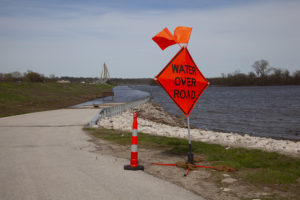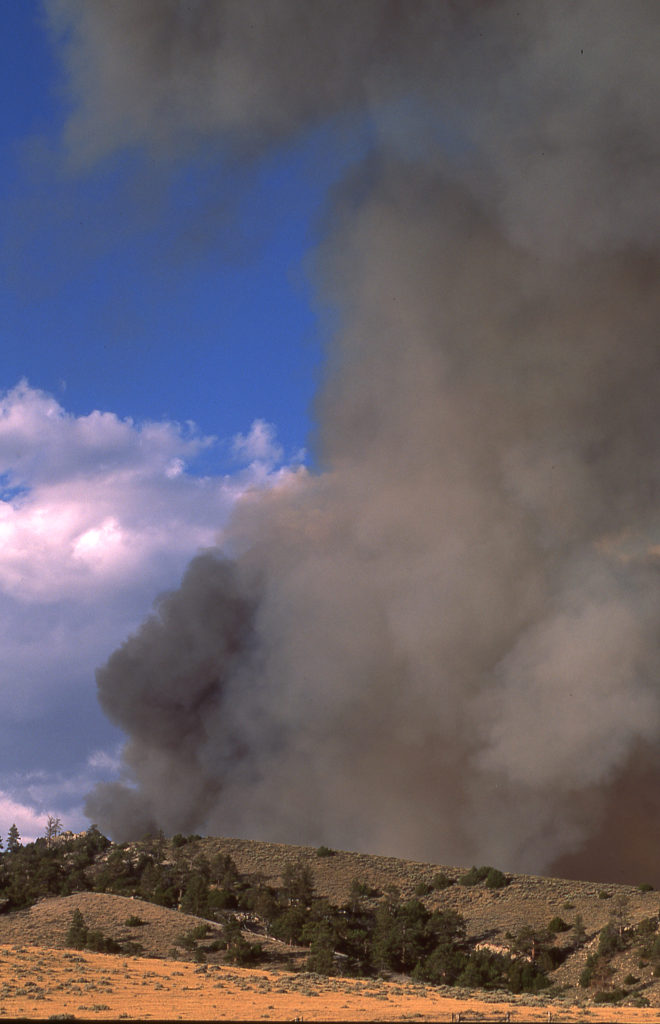
The dust storms of the Dirty Thirties are returning to the high plains of America’s heartland. This storm ripped across eastern Colorado and northwestern Kansas in March of 2014. Photo copyright 2014, Chris Madson, all rights reserved.
AS THE DISCUSSION OVER CLIMATE CHANGE— OR DEBATE OR DONNYBROOK, HOWEVER YOU PREFER TO THINK OF IT— CONTINUES, I THINK IT’S appropriate to pause at the beginning of the new year and consider the adventures in weather we’ve enjoyed across the United States over the previous twelve months. For those of us who have ducked the nastiest the atmosphere has generated, it’s easy to forget the storms, fires, and droughts that caused significant inconvenience across the country. So, in the interest of recalling some of the nation’s most spectacular events, here’s a quick review of 2019 in weather:
Things started off in late February with a strong Arctic cold front that dropped more than a foot of snow on parts of Iowa, Minnesota, and Wisconsin, driven by winds of nearly sixty miles an hour.[i] As the blizzard moved east, the wind intensified, reaching gust of nearly seventy miles an hour in Massachusetts, New York,[ii] and southern Ontario[iii]. Farther south, the

Flood water on the upper Mississippi River near Alton, Illinois. Photo copyright 2019, Chris Madson, all rights reserved.
system brought nearly a foot of rain to the Tennessee valley, causing extensive flooding.[iv] On the night of February 23, the front triggered several tornados, including an EF3 twister that leveled much of the business district in Columbus, Mississippi, and killed one person. Altogether, the storm caused an estimated $1.3 billion in damage and claimed two lives.[v]
On March 14, a strong storm system rolled into the northern plains. With much of the region still in the grip of winter, the heavy rain caused rapid snow melt, all of which ran off still-frozen ground. Nebraska and western Iowa took the brunt of the flooding, but there was significant damage from eastern North Dakota to Missouri as well as Wisconsin and Michigan. The early runoff set the stage for flooding farther down the Mississippi watershed. Estimates of damage ran to $10.8 billion. Three people lost their lives.[vi]
Meanwhile, on the southern plains, severe hail storms from March 22 to March 24 pummeled Oklahoma City, Dallas, and surrounding farmland. People who have not seen a hail storm on the Great Plains would be shocked at the devastation one can inflict. Damage was estimated at $1.6 billion.
A cold front on April 13 and 14 swept through the Southeast, spawning more than fifty tornados across central Mississippi and Alabama and another twenty-five from Georgia to Pennsylvania. High wind and hail also caused damage in several areas. After the front had passed, damage was estimated at $1.3 billion. Seven lives were lost.[vii]
Again on May 16 through 18, a strong cold front caused severe thunderstorms across Illinois, Indiana, Iowa, and Texas. Another $1.0 billion in damage.
Yet another storm front swept across the Great Plains and on to Ohio, Pennsylvania, and New Jersey from May 26-29. The front spawned 190 tornados, damaging hail, and high winds. Salient among the tornados was an EF3 twister that touched down near Dayton, Ohio, killing one person. Damage estimate: $4.5 billon. Three persons killed.
This succession of storm fronts also led to major flooding in the Arkansas River watershed, from eastern Oklahoma to Little Rock, Arkansas. Officials estimated $3.0 billion dollars in damage and attributed five deaths to the high water.
The flooding that began at the end of winter in the upper Midwest continued through the end of July in many parts of Oklahoma, Kansas, Nebraska, Missouri, Illinois, Arkansas, Kentucky, Tennessee, Texas, Mississippi, and Louisiana as well as parts of Indiana and Ohio. The cumulative damage done to industry and agriculture by these floods is estimated at $6.2 billion. Four deaths were blamed on the high water.[viii]
On July 4 and 5, storms with hail up to one inch in diameter went through the Denver metro area. Damage was estimated at $1.0 billion.
Then came the hurricane season. By the standard of 2018, it was relatively mild, but in late August, Dorian came ashore in North Carolina, causing $1.6 billion in damage and killing ten people. On September 17, Tropical Storm Imelda brought almost three feet of rain to the Houston area, causing another $5.0 billion in damage and claiming five more lives.[ix]
On October 20, a nasty low-pressure system rolled over Dallas, then continued to Oklahoma, Missouri, Arkansas, Louisiana, and Tennessee. Estimate of damage: $1.7 billion. Two people killed.[x]
Out in California, the drought that was largely responsible for the catastrophic fires season of 2018 finally broke. The moisture

Rising temperatures and deepening drought set the stage for wildfires across much of the West. This fire burns near Casper, Wyoming. Photo copyright 2012, Chris Madson, all rights reserved.
during the winter and early spring allowed much of the vegetation in the state to recover, which, in turn, provided exceptional fuel for yet another round of wildfires. State officials estimated that almost 8,000 fires consumed nearly 260,000 acres in 2019, destroying more than 700 buildings and killing three people.[xi] Pacific Gas and Electric, the utility whose power lines were found to be responsible for several of the most damaging fires in 2018, took the precaution of turning off electricity to as many as 2.7 million people[xii] when high wind threatened to bring down more electrical lines in 2019. The resulting losses of power were said to be responsible for more than $2 billion in additional economic loss.[xiii]
While it rained— and rained— in America’s heartland, southeastern Alaska found itself in the grip of a major dry spell, beginning in July 0f 2018 and continuing through much of 2019.[xiv] The city of Juneau set all-time records for high temperatures, and, farther north, the ice pack along the melted early as temperatures in the Arctic Ocean were as much as nine degrees above average.[xv]
The heat and drought created ideal conditions for wild fires. By late summer, more than 2.5 million acres had burned, less than the 2004 record of 6.5 million acres but still worrisome. According to Scott Rupp, deputy director of the International Arctic Research Center in Fairbanks, “What has been changing is the frequency and the magnitude of these fires.”[xvi]
The combination of the fires in California and Alaska did an estimated $4.5 billion in damage and claimed the lives of three people.[xvii]
These are 2019’s biggest weather events: $45 billion in damage and forty-four people dead. Compared to 2018, we got off easy. As you may recall, there were three killer hurricanes in 2018, along with drought and fires and hail. Severe weather alone caused $223 billion in 2018 and took something like 282 lives. Still, even a quiet year like 2019 gets my attention. Forty-five billion here, 45 billion there— pretty soon, you’re talking serious money.
No one knows what 2020 will bring, but the people who have studied climate most carefully say the chances are that it will be worse. It’s impossible to say whether any or all of these events were caused by the increasing amount of heat in the atmosphere, impossible to know if they were just made worse. But these events, their severity and impact, are perfectly consistent with the predictions that several independent groups of researchers have made. In fact, there’s growing reason to believe that the predictions made by the International Panel on Climate Change and other reputable research groups have been unduly conservative, which is to say that things in the real world are getting worse faster than many scientists had predicted.
This year, next year, the year after that, we’ll set new records for high temperatures, new records for intense rainfall, for tornados, hurricanes, flooding, wild fires, even for paralyzing blizzards. The cost in damage and lost lives is the price we pay just to “adapt” to a changing climate. That cost will increase at an alarming rate over coming decades because “adapting” to the changing climate does nothing to stop the root cause— more and more energy trapped in the atmosphere, the oceans, and the land mass of the planet Earth by greenhouse gases. It’s like treating a serious infection with a damp washcloth and an aspirin— it may ease the suffering for a while, but it’s no substitute for an antibiotic.
In the year 2020, we’ll have no choice but to cope with the symptoms of climate change. But that won’t cure the disease.
————–
[i] https://www.weather.gov/arx/feb2419
[ii] https://www.weather.gov/dtx/highwindwarning190224
[iii] https://www.ctvnews.ca/canada/high-winds-lash-southern-ontario-maritimes-under-storm-warnings-1.4310412
[iv] https://www.weather.gov/ohx/lateFebruary2019flooding
[v] https://www.ncdc.noaa.gov/billions/events
[vi] https://www.ncdc.noaa.gov/billions/events
[vii] https://www.ncdc.noaa.gov/billions/events
[viii] https://www.ncdc.noaa.gov/billions/events
[ix] https://www.ncdc.noaa.gov/billions/events
[x] https://www.ncdc.noaa.gov/billions/events
[xi] https://www.fire.ca.gov/incidents/2019/
[xii] https://www.nytimes.com/2019/10/26/us/Kincade-Fire-Sonoma-California.html
[xiii] https://www.cnbc.com/2019/10/10/pge-power-outage-could-cost-the-california-economy-more-than-2-billion.html
[xiv] https://weather.com/news/climate/news/2019-05-28-extreme-drought-southeast-alaska
[xv] https://www.usatoday.com/story/news/nation/2019/07/01/alaska-heat-wave-record-heat-fuels-wildfires-melting-sea-ice/1616992001/
[xvi] https://www.usatoday.com/story/news/nation/2019/07/01/alaska-heat-wave-record-heat-fuels-wildfires-melting-sea-ice/1616992001/
[xvii] https://www.ncdc.noaa.gov/billions/events
Leave a Reply
You must be logged in to post a comment.